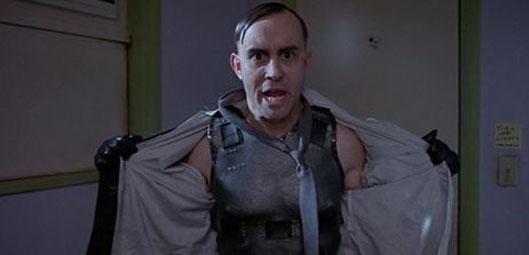
The Frighteners (Movie Review)
(The following review is based on the “Director’s Cut” version of “The Frighteners” included on the film’s recent Blu-Ray release.)
For me, before there was Peter Jackson’s “Bad Taste” or “Dead Alive” there was “The Frighteners”. A movie that combined Marty McFly and a plot that could have been used for a “Ghostbusters” sequel?! My prepubescent, chubby nerd-self could hardly contain the excitement. What I do remember about seeing “The Frighteners” during its initial release was being struck at just how strange the film seemed. Not in a derogatory sense in that the film was uneven or slow, but that the experience of watching the film unfold was truly different. Yes, there were the general creeps and chuckles of any solid horror comedy but what really stuck with me was the sensation of having experienced a movie by filmmakers who had such a tangible sense of place and tone.
But now—having furthered my education in the hallowed corridors of interwebs movie nerdom—it is easy to see where this tone comes from. You have Peter Jackson in the director’s chair and as writer along with Fran Walsh. Robert Zemeckis executive produces. Danny Elfman provides the score. Rick Baker has some effects work. Dee Wallace Stone is back at it! The film is also representative of WETA’s first steps into the international effects world as they took advantage of increasingly affordable CGI technology. Indeed, the film announces itself quite boldly with an opening sequence that is a flat out horror setup complete with a “dark and stormy night” at a secluded Gothic house in which a ghost terrorizes the residents. It’s an old school carnival haunted house. The camera moves through windows and floors as we hear screaming from inside. We see a human shape crawling under walls and under carpets, knocking off cabinets and reaching out for the terrified inhabitants. It’s a film that loves hauntings and ghost stories but can still poke fun at its some of it’s own trivial plot points. But for all the technical prowess, self-effacing humor, and fresh stylization, which still holds up (for the most part), the film still has some messy moments and uneven execution.
The film’s central protagonist is Frank Bannister (Michael J. Fox), a reclusive paranormal investigator/unapologetic con-man who can see and communicate with ghosts, an ability he gains following a tragic car wreck that kills his wife (or so it seems…cue maniacal laughter). Frank enlists the help of ghosts Cyrus, Stewart, and The Judge—a begotten disco king, nerdy bookworm, and old West lawman respectively—to fake hauntings so Frank may “clear” the house for a hefty fee. Frank stalks funerals and cruises the obituaries for freshly bereaved clientele all the while attempting to finish a home he was building for himself and his late wife. It’s a piece of symbolism that is both awkwardly obvious and appropriate.
Frank and company’s routine is troubled when a series of unexplainable deaths begins to plague town. Seemingly healthy citizens are being found with their hearts crushed inside their chests. Frank then begins to see a caped figure with a large sickle appearing at each of the murders. He is able to witness the murders happening but he is incapable of acting in defense of the victims. Like the unfinished house, this is another piece of symbolism that has an awkward sense of being slightly too on the nose but also a fresh take on visualizing grief and the cyclical experience of reliving a traumatic memory.
It is revealed the hooded ghost to be Johnny Bartlet (Jake Busey) who, together with his girlfriend Patricia Bradley (Dee Wallace Stone), went on a killing spree in a local hospital thirty years prior. However, a government agent named Dammers (Jeffery Combs) complicates matters when he arrests Frank on the suspicion he is to blame for the murders. Jeffery Combs is one of the brightest spots in this film. His halting speech, shifting eyes, and gesticulations make the character into a coiled spring that can snap at even given moment. Dammers is a fascinating character in that he is a bureaucratic servant to the government who attempts to compartmentalize and explain events that are beyond him and the capacity of rational institutions. He becomes a violent and interesting antagonist to Frank, someone who represents Frank’s guilt while also getting to deliver some fantastic one-liners.
“The Frighteners” does have a few rough spots. In particular the film’s humor seems to fall a little flat at times or just doesn’t quite go far enough in it’s execution (which is really strange to say given this is a film from the same man who had a group of people eating zombie puss in “Dead Alive”). There are a number of moments that try to play up on cutesiness but in doing so undercut any of the rules the world sets out for itself. Prior to terrorizing a wealthy woman into calling Frank, Stewart and Cyrus are shown having a conversation with a baby asking it to help them scare the child’s parents. The baby laughs and bounces and the crowd’s eyes roll. Then, at other times you become increasingly aware that you are watching a computer more so than the interactions of characters with each other and their environment. Because of this, a number of the jokes the filmmakers try to go for fall flat. There is this sense that Jackson and the effects team had not really figured out how to incorporate CGI into a physical comedy routine. Finally, Jackson’s depiction of Patricia and Johnny’s sexuality seems to imply that women with overly aggressive sexual desires are more likely to be crazed lunatics. At one moment, we even watch as Patricia stabs Johnny’s ghost with a kitchen knife while they both moan orgasmically.
But despite these few problems, “The Frighteners” still maintains a fresh, vibrant sense of itself. It’s certainly a representative work of Jackson’s ability to create cinematic worlds.

